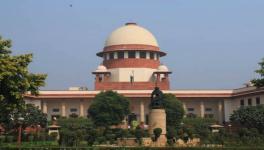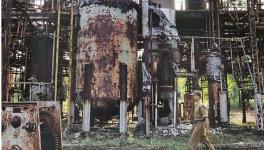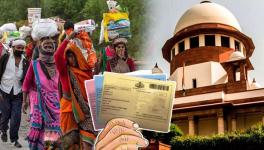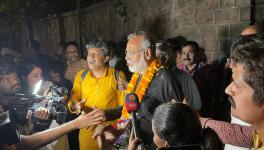Gujarat Elections: Rising Fodder Prices in Banskantha’s Dairy Hub Milking Small Farmers Dry
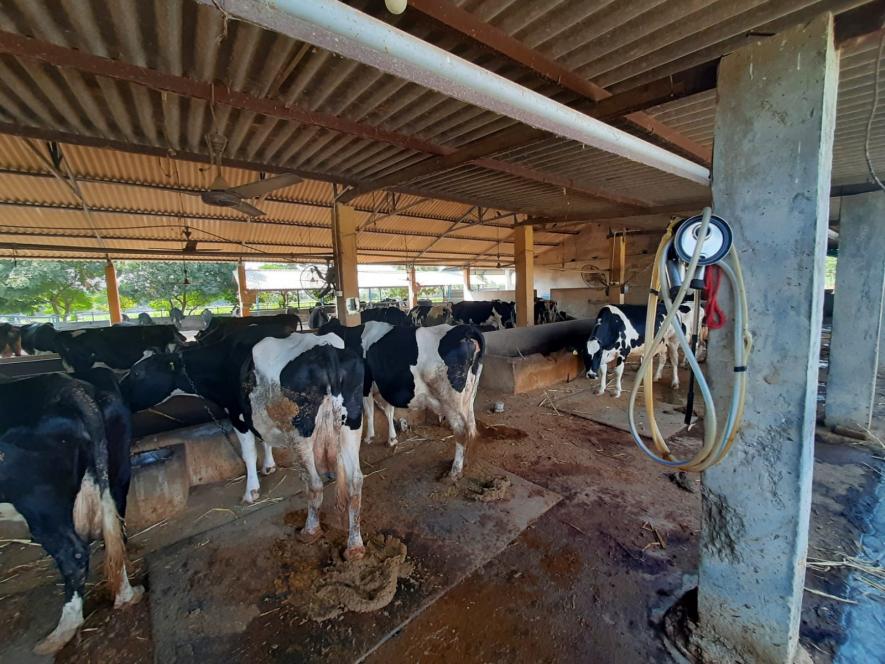
A view of the stable of the well-to do farmers of Thawar village in Banaskantha
Banaskantha: Banaskantha district in North Gujarat is home to Asia’s largest dairy industry. Within the district lies the village of Thawar which alone produces around 70,000 litres of milk daily. This milk is supplied to the different branches of Banas dairy from where it reaches all the way up to Delhi and Uttar Pradesh. What is interesting is the role of small farmers in the industry and how, what earlier was an extra source of income, is now becoming more of a burden them.
A constituency where the poll game is absolutely tight with a neck-and-neck fight in offing, Dhanera this year is likely to have a three-way contest with the Aam Aadmi Party (AAP) likely to split BJP and Congress votes in its favour.
In the previous elections, Congress won by a thin margin of only 2,093 votes. The constituency has a massive vote bank of 2,62,000 voters. What's important to note here, is that despite a massive 25% stake, combining the Scheduled Castes (SC) and Scheduled Tribes (ST), no leader from these minority communities has been fielded ever by BJP or Congress.
Ramesh Prema Vankar, a resident of Thawar, owns two buffaloes and one cow. The 35-year-old has always survived on animal husbandry but recent times have been more difficult than others.
“Amid rising prices of literally everything, it is becoming impossible for me to sustain solely on the cattle I have,” he told NewsClick. His family never owned land where he could do farming, and animal husbandry was always the profession that was followed. He has two brothers who also work in the same profession.
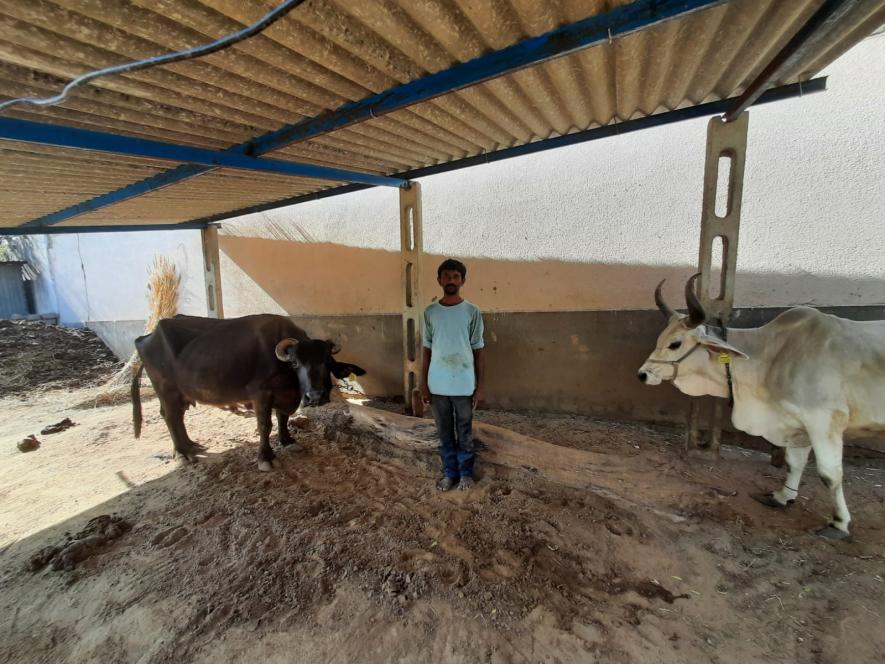
Ramesh inside his stable
As a kid, Vankar never saw tough times owing to the profession that he now nearly despises. Things have changed for the family in the past three-four years. Managing supplies for the cattle, for the family and supporting the education of his children have forced him to do multiple jobs that pay less than the amount of labour that he does.
Explaining his daily routine to NewsClick, the middle-aged Ramesh says: “I wake up at 5 in the morning and work in the stable. After this, the little milk that is produced is taken to the nearby government cooperative dairy where I sell it.” Following this, he spends a little time with his wife while drinking morning tea after which the couple leaves for work.
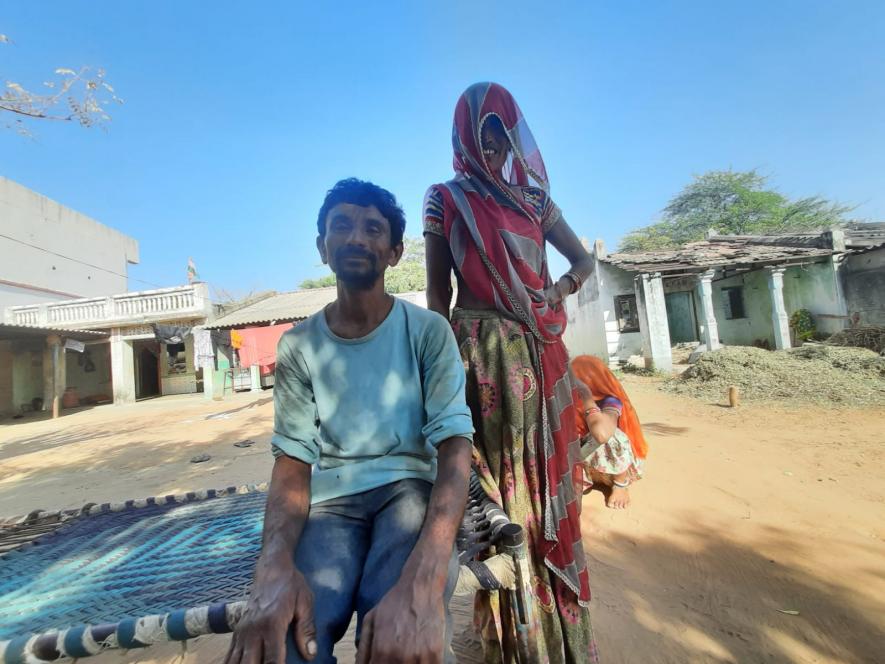
Ramesh Vankar with his wife Seema Vankar, both are currently daily wage earners along with little cattle they have
Seema works under the Mahatama Gandhi National Rural Employment Guarantee Act (MGNREGA) scheme from 7 a.m to 1 p.m where she earns Rs 200 a day. Ramesh goes to work in the land of a Patel in the same village. This goes on for a couple of hours after which he works at another stable of a big farmer who owns around 100 cows and buffaloes.
After lunch, a similar routine, first work in the stable owned by an upper caste man and then at his own place, and then he goes for a second round at the dairy, where he sells the evening milk.
“By the time I am done preparing for the next day, feeding the cattle, and cleaning the place, it is usually 10 p.m. I come home only to find my family asleep,” said Ramesh. He ends up having dinner alone every night and goes to sleep dead tired.
As per some local residents, around 5% of the entire Thawar village farmers own at least 100 cows and buffaloes, most of the middle-class families number between 10-15, and the rest of the damilies, like Ramesh’s, have no land and rely on multiple daily wage jobs. For someone like Ramesh, who has never seen a time like this in his life, handling the prices of daily food items, especially cattle fodder, is becoming more difficult by the day.
When it comes to the government handling the issues of the people, many said they were happy with their representative only for one reason. “The only thing the current MLA Nathabhai Patel has done is build roads here. Earlier, there were no proper roads in the constituency, while we needed them the most as from fodder to milk, transportation is a big factor,” a resident of Dhanera constituency told NewsClick. Another local, however, said: “The highway roads were made six months ago. It's all broken now. What material do these people use?”
Kala Parmar, 45, who owns some three bighas of land and 15 cows and buffaloes, said “One bag of fodder costs around Rs1,400-1,900. This price three years ago used to be Rs600-800. While the cost of fodder has almost doubled, the price of milk in the recent years has gone up only by Rs 1-2,”. The primary point of concern for these farmers, therefore, is the consistent and abnormal rise in fodder prices in recent years. Many have been compelled to leave animal husbandry altogether as it has become more of a financial burden.
News reports in the past have highlighted that fodder inflation reached a nine-year-high at 25.54% in August 2022 leading to small farmers bearing the maximum brunt.
In Banaskantha, the problems multiply owing to the existing water scarcity. Since there is no water until 1,000 feet below ground in many areas, farmers are unable to do farming in all three seasons, hence they rely on animal husbandry. Many who have land are able to adjust their income as per the availability of land they have, the rest suffer.
Although the government did promise to create 100 fodder Farmers Producing Organisations (FPOs), the plans have remained on paper to date. For landless farmers, such as Ramesh, who do not own land, cattle food is becoming an expensive investment even with the small number of animals they have. “I might sell all my cattle by next year if the government does not come our rescue now,” said Ramesh.
While procuring fodder is a challenge, for a person like Ramesh who comes from the Vankar community (SC), there is a separate set of conflict, too. “I do not have the option to sell in the local dairies that sell milk or the retailer shops that sell tea in the market. Usually, a person would manage to sell off their crop in the private market, but when I tried doing the same, my caste comes in the way. They say if they buy my milk, nobody will have tea here, and our shops will become impure,” he said.
The quality of milk produced plays a big role in the markets of North Gujarat, especially with the Banas dairy. The cattle of small-scale farmers who fail to feed them with the healthiest fodder ends up producing milk with low-fat content. This further leads to huge losses, because the dairy in-charge rejects milk with low-fat content.
Kala said he had to face this problem multiple times this summer. At least twice a month, 10lt out of the total 50lt milk he sold was returned. “It badly imbalances our budget. We have no control over the quality of milk that a cow or buffalo is capable of producing. All the milk that is returned ends up being thrown away,” he said. With sustainability already becoming difficult, unsold milk becomes an additional hurdle for small and medium-scale producers.
NewsClick, while observing the conditions of different farmers, saw disparity in the treatment meted out to farmers in different dairies. While the ones to sell 500lt of milk daily were happy with the system and got only better financially, the ones in the absolutely dilapidated state found it difficult to make both ends meet and were on the verge of ending their cattle business.
The disparity is reflected in the prices as well. In an area inside Thawar, a supermarket and a branch of Banas dairy are located side by side. While the price of milk that a farmer would get at the dairy is Rs 30-35 a litre, the same milk would cost Rs 60 in the mall right beside the branch.
The caste story reads different in Vasan, a village only 2 km away from the Rajasthan border. The deserted village with barren land and no roads is the last village of the district Banaskantha and the state of Gujarat before one enters Rajasthan. Here lies the Banas dairy where a different game of discrepancies runs.
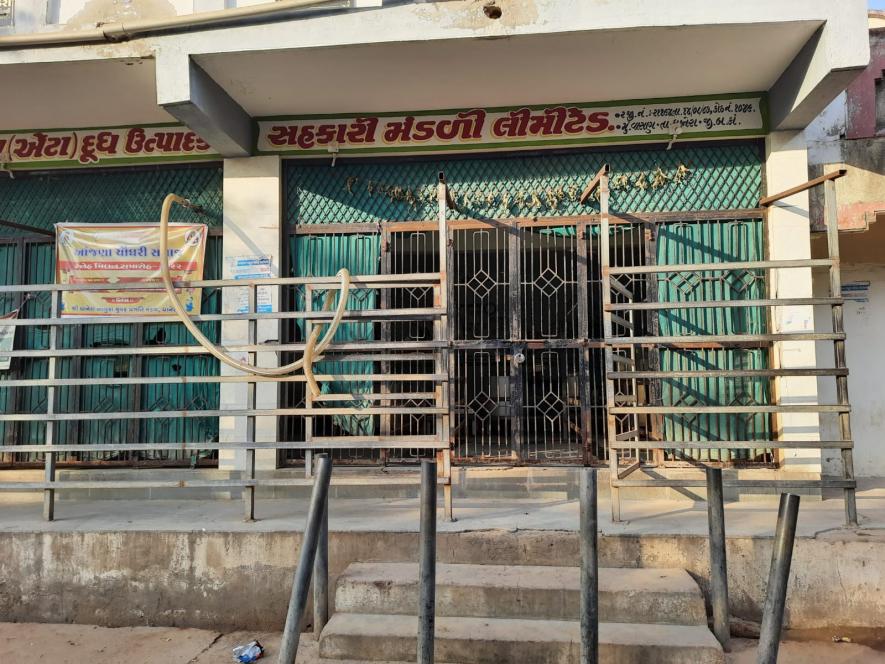
The Banas dairy branch in Vasan, the last village in Gujarat before Rajasthan
The farmers of Vasan alleged that even though the milk produced by them was rich in fat, the dairy head consistently rejects their milk. When speaking to the savarnas (upper castes) of the village, NewsClick found them to be happy with the situation there. However, the same was not the case for dalits of the village.
The entire committee in the Vasan branch of Banas Dairy consists of Patels and Chaudharis who come under the OBC (Other Backward Classes) category. The machine that is used to measure fat lies behind white curtains in Vasan, as alleged by the villagers there, thereby leaving no chance for them to cross-check whether fat content in their milk was actually less or not. Machan, one of the rebellious farmers from the dalit community, said he had often raised his voice to remove the ‘purdah’ (curtain) but was silenced every time in the name of his caste.
Owing to less fat in their milk, the dalits of the village get Rs 25/lt for the same milk supposed to be sold at a better price of at least Rs 30. Since literacy among dairy farmers across North Gujarat is low, they fail to verify the accuracy of the fat content, as told to them by checkers.
The bigger farmers in the dairy hub of Banaskantha Thawar, lead the game of milk monopoly. And they have up to six employees like Ramesh who work for them. This significant shift of the landless marks a threat to the business of small-scale dairy producers in the dairy hub of rural North Gujarat.
The writer is a Delhi-based freelance journalist. He is travelling in Gujarat to cover the elections.
Get the latest reports & analysis with people's perspective on Protests, movements & deep analytical videos, discussions of the current affairs in your Telegram app. Subscribe to NewsClick's Telegram channel & get Real-Time updates on stories, as they get published on our website.










